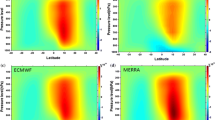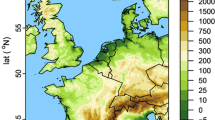Abstract
We present a comparison of the zonal mean meridional circulations derived from monthly in situ data (i.e. radiosondes and ship reports) and from the NCEP/NCAR reanalysis product. To facilitate the interpretation of the results, a third estimate of the mean meridional circulation is produced by subsampling the reanalysis at the locations where radiosonde and surface ship data are available for the in situ calculation. This third estimate, known as the subsampled estimate, is compared to the complete reanalysis estimate to assess biases in conventional, in situ estimates of the Hadley circulation associated with the sparseness of the data sources (i.e., radiosonde network). The subsampled estimate is also compared to the in situ estimate to assess the biases introduced into the reanalysis product by the numerical model, initialization process and/or indirect data sources such as satellite retrievals. The comparisons suggest that a number of qualitative differences between the in situ and reanalysis estimates are mainly associated with the sparse sampling and simplified interpolation schemes associated with in situ estimates. These differences include: (1) a southern Hadley cell that consistently extends up to 200 hPa in the reanalysis, whereas the bulk of the circulation for the in situ and subsampled estimates tends to be confined to the lower half of the troposphere, (2) more well-defined and consistent poleward limits of the Hadley cells in the reanalysis compared to the in-situ and subsampled estimates, and (3) considerably less variability in magnitude and latitudinal extent of the Ferrel cells and southern polar cell exhibited in the reanalysis estimate compared to the in situ and subsampled estimates. Quantitative comparison shows that the subsampled estimate, relative to the reanalysis estimate, produces a stronger northern Hadley cell (∼20%), a weaker southern Hadley cell (∼20–60%), and weaker Ferrel cells in both hemispheres. These differences stem from poorly measured oceanic regions which necessitate significant interpolation over broad regions. Moreover, they help to pinpoint specific shortcomings in the present and previous in situ estimates of the Hadley circulation. Comparisons between the subsampled and in situ estimates suggest that the subsampled estimate produces a slightly stronger Hadley circulation in both hemispheres, with the relative differences in some seasons as large as 20–30%. 6These differences suggest that the mean meridional circulation associated with the NCEP/NCAR reanalysis is more energetic than observations suggest. Examination of ENSO-related changes to the Hadley circulation suggest that the in situ and subsampled estimates significantly overestimate the effects of ENSO on the Hadley circulation due to the reliance on sparsely distributed data. While all three estimates capture the large-scale region of low-level equatorial convergence near the dateline that occurs during El Nino, the in situ and subsampled estimates fail to effectively reproduce the large-scale areas of equatorial mass divergence to the west and east of this convergence area, leading to an overestimate of the effects of ENSO on the zonal mean circulation.
Similar content being viewed by others
Author information
Authors and Affiliations
Additional information
Received: 16 September 1998 / Accepted: 22 April 1999
Rights and permissions
About this article
Cite this article
Waliser, D., Shi, Z., Lanzante, J. et al. The Hadley circulation: assessing NCEP/NCAR reanalysis and sparse in-situ estimates. Climate Dynamics 15, 719–735 (1999). https://doi.org/10.1007/s003820050312
Issue Date:
DOI: https://doi.org/10.1007/s003820050312




